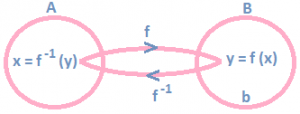Definition: Let f: A → B and g: B → C be two functions. Then a function gof: A → C defined by (gof)(x) = g(f(x)), for all x ϵ A is called the composition of f and g. Note 1: It is evident from the definition that gof is defined only if for each x ϵ A, f (x) is an element of g so that we can take its g – image. Hence, for the composition gof to exist, the range of f must be a subset of the domain of g.
Note 1: It is evident from the definition that gof is defined only if for each x ϵ A, f (x) is an element of g so that we can take its g – image. Hence, for the composition gof to exist, the range of f must be a subset of the domain of g.
Note 2: It should be noted that gof exists if the range of f is a subset of domain of g. similarly, fog exists if range of g is a subset of domain of f.
Example: Let f: R → R; f (x) = sin x and g : R → R, g (x) = x² find fog and gof.
Solution: Clearly, fog and gof both exist.
Now, (gof)(x) = g(f(x)) = g(sinx) = (sinx)² = sin²x
And, (fog)(x) = f(g(x)) = f(x²) = sinx².
Example: Let f(x) \(=\left\{ \begin{align}& 1+x,\,\,\,\,\,0\le x\le2 \\& 3-x,\,\,\,\,\,2<x\le 3 \\\end{align} \right.\) find fof (x).
Solution: We have, fof (x) = f(f(x))
x \(=\left\{ \begin{align}& f\left( 1+x \right),\,\,\,\,\,0\le x\le 2 \\& f\left( 3-x\right),\,\,\,\,2<x\le 3 \\\end{align} \right.\)
\(=\left\{ \begin{align}& f\left( 1+x \right),\,\,\,\,\,0\le x<1 \\& f\left( 1+x \right),\,\,\,\,\,1<x\le 2 \\& f\left( 3-x \right),\,\,\,\,2<x\le 3 \\\end{align} \right.\).
\(=\left\{ \begin{align}& 1+\left( 1+x \right),\,\,\,\,\,0\le x<1 \\ & 3-\left( 1+x \right),\,\,\,\,\,1<x\le 2 \\& 1+\left( 3-x \right),\,\,\,\,2<x\le 3 \\\end{align} \right.\).
\(=\left\{ \begin{align}& 2+x,\,\,\,\,\,0\le x\le 1 \\& 2-x,\,\,\,\,\,1<x\le 2 \\& 4-x,\,\,\,\,2<x\le 3 \\\end{align} \right.\).
PROPERTIES OF COMPOSITION OF FUNCTIONS:
Property 1: The composition of functions is not commutative i.e., fog ≠ gof.
Property 2: The composition of functions is associative i.e., if f, g, h are three functions such that (fog)oh and fo(goh) exist, then (fog)oh = fo(goh).
Property 3: The composition of two bijections is a bijection i.e., if f and g are two bijections, then gof is also a bijection.
Property 4: Let f : A → B. Then foIA = IBof = f i.e., the composition of any function with the identity function is the function itself.
Inverse of an Function: If f : A → B is a bijection, we can define a new function from B to A which associates each element y ϵ B to its pre-image f¯¹ (y) ϵ A. Such a function is known as the inverse of function f and is denoted by f¯¹. Example: If f : R → R is a bijection given by f (x) = x³ + 3, find f¯¹ (x).
Example: If f : R → R is a bijection given by f (x) = x³ + 3, find f¯¹ (x).
Solution: Let f (x) = y then, f (x) = y
⇒ x³ + 3 = y
⇒ x = (y – 3)⅓
⇒ f¯¹ (y) = (y – 3)⅓
Thus, f¯¹ : R → R is given by f¯¹ (x) = (x – 3)⅓ for all x ϵ R.
PROPERTIES OF INVERSE OF A FUNCTION:
Property 1: The inverse of a bijection is unique.
Property 2: The inverse of a bijection is also a bijection.
Property 3: If f : A → B is a bijection and g : B → A is the inverse of f then fog = IB and gof = IA, Where IA and IB are the identity functions on the sets A and B respectively.
Property 4: If f : A → B and g : B → C are two bijections, then gof : A → C is a bijection and (gof)¯¹ = f¯¹og¯¹
Property 5: Let f : A → B and g : A → B be two functions such that gof = IA and fog = IB. Then, f and g are bijections and g = f¯¹.
Example: Show that the function f : R → R given by \(f\left( x \right)={{\log }_{a}}\left( x+\sqrt{{{x}^{2}}+1} \right)\), a > 0, a ≠ 1 is invertible and find its inverse.
Solution: In order to prove that f (x) is invertible, it is sufficient to show that f is a bijection.
f is an injection: Let x, y be any two distinct real numbers. Then, x ≠ y.
⇒ \(x+\sqrt{{{x}^{2}}+1}\ne y+\sqrt{{{y}^{2}}+1}\).
⇒ \({{\log }_{a}}\left( x+\sqrt{{{x}^{2}}+1} \right)\ne {{\log }_{a}}\left( y+\sqrt{{{y}^{2}}+1} \right)\).
⇒ f (x) ≠ f (y)
⇒ f is an injection.
f is a surjection: Let f (x) = y Then, \({{\log }_{a}}\left( x+\sqrt{{{x}^{2}}+1} \right)=y\).
\(x+\sqrt{{{x}^{2}}+1}={{a}^{y}}\).
\(-x+\sqrt{{{x}^{2}}+1}={{a}^{-y}}\).
∴ 2x = (ay – a-y)
\(x=\left( \frac{{{a}^{y}}-{{a}^{-y}}}{2} \right)\).
Thus, for every y ϵ R, there exists \(x=\frac{{{a}^{y}}-{{a}^{-y}}}{2}\in R\) such that f (x) = y. Therefore, f is a surjection.
Hence f is a bijection. Consequently, it is invertible.
In order to find f ¯¹ let f (x) = y
⇒ \({{\log }_{a}}\left( x+\sqrt{{{x}^{2}}+1} \right)=y\).
⇒ \(x+\sqrt{{{x}^{2}}+1}={{a}^{y}}\).
⇒ \(-x+\sqrt{{{x}^{2}}+1}={{a}^{-y}}\).
∴ 2x = (ay – a-y)
⇒ x = ½ (ay – a-y)
⇒ f ¯¹ = ½ (ay – a-y)
Hence, f ¯¹ (x) = ½ (ax – a-x)
